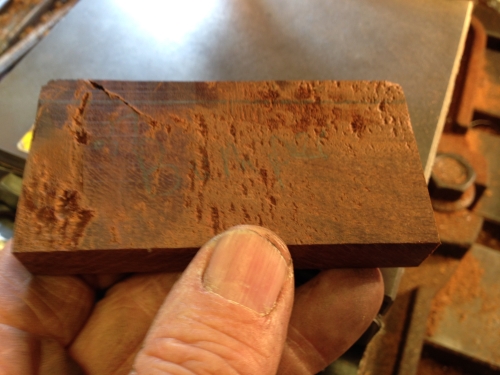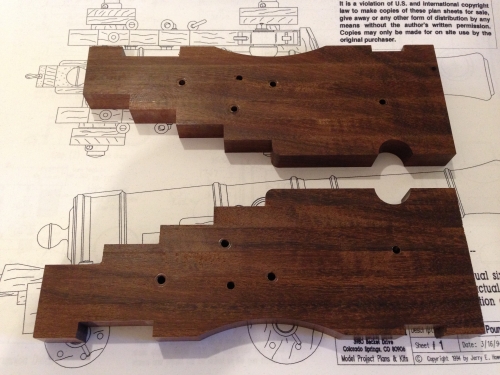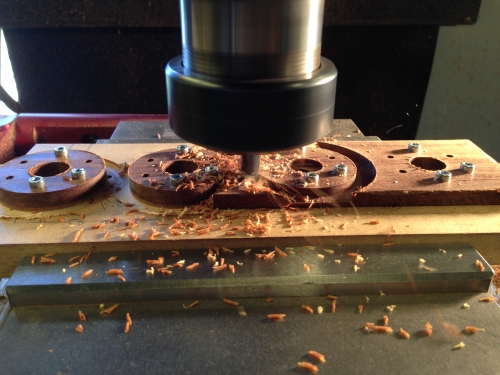DESERT IRONWOOD
by John
Some decades ago I made a table for our kitchen. (cannot find photo just now, will add one later)
I bought the wood from a wood recycler. He removed trees from Melbourne suburban gardens, then cut them into slabs and air dried them.
I recall that I paid about $AUD 1000 for the 6-8 planks. They were about 40mm thick and 300mm wide and about 2.5m long. They were so heavy that I could barely lift them.
I have since learned that they weigh 1.1 to 1.4 tonnes per cubic metre, which is at the high limit of wood densities.
The tree must have been 400mm diameter, because some slabs still had the bark attached to both sides.
The wood has a beautiful dark brown colour, with almost white sapwood solidly attached. It is unbelievably hard, and I struggled to machine it with my thicknesser/buzzer. Also, it was the most reactive wood I have ever worked. When planed or thicknessed it would bend and react totally unpredictably. My 40-45mm thick planks ended up 25-28mm thick and even then they were not totally flat.
But SWMBO liked the table, and it still is the main meal table in out house. One of my daughters requested a similar table, which I made from Gippsland Blue gum, another spectacular dense hard Australian wood.
The ironwood has survived kids dancing on it, steam engine demonstrations, being used as a work bench, not to mention many meals with never a table cloth. And the wood itself is unmarked! The polish has disappeared in places, but the wood itself seems impervious to damage.
To get to the point of this post, I am currently making a 1779, 24 pounder, 1:10 scale naval cannon. Jerry Howell design. About 300mm (one foot) long.
When I was looking in my shed I considered various woods for the carriage-base. I considered some black walnut, which was recommended, but it seemed a bit light in weight and colour. I considered some Australian redgum, which polishes beautifully, and is dense and tough, but it is a bit too red. Some African Odum looked possible, but the figuring is a bit plain. Then I found some ironwood offcuts from the table job, and the decision was made. Ironwood it is.
So here are the initial photos of the carriage parts. They were machined on my metalworking mill, using HSS cutters. I CNC’d where possible.

Ironwood after conventional thicknessing. Tearouts are a problem.

Ironwood after surfacing with a 1″ endmill. Here I am CNCing the profile of the carriage. 3000rpm, 500mm/minute.

After milling, I am tempted to just oil the surface. The edges are sharp, like milled metal.

CNCing the wheels.

A little deburring or with wood is it called defuzzing? required
Watch this space for progress on the cannon.
There are some technical challenges, including deep boring 14mm diameter 275mm deep, making a tiny dovetail in the ironwood, and turning the barrel from 50mm diameter brass.

Are you going to cast some cannon balls?
LikeLike
I hav not considered that option, but maybe. Ball bearings might be easier option.
LikeLike
All you need to make them is a nice tall shot tower.
LikeLike
that would work. how about I use your chimney.
LikeLike
That is an absolutely beautiful cannon you made. I also enjoyed reading the info on the cannons you wrote. I came across your site searching for info on a vintage model cannon that belonged to my father that I have. My parents are passed so no info from them where and when it was purchased. I’ve searched everywhere and haven’t seen one like it. It is the same shape as the one you made but longer platform at the back, maybe for someone to stand on. The barrel has beautiful etched designs all over it. My father was stationed in Italy during the war and he may have brought it back with him when he returned home. I really hope I can find what cannon it was modeled after, where and the year it was made. I’m intrigued by these model cannons and the workmanship that you craftsman do to build them.
They truly are a work of art.
Well off to try and find some history on mine
LikeLike
Thanks for the feedback Liz. If you can send me some pics of your cannon, I will see if I can help identify it for you. jviggers@iinet.net.au
LikeLike
Hi
I see from the pictures you have very nice drawings for the 1779 canon, are they available
Regards
LikeLike
Hi Johan,
I bought them from this source. Not expensive.
Search “Jerry E Howell 1779 cannon plans”
The plans are good, except that the carriage sides are parallel, and should be sloped .
LikeLike